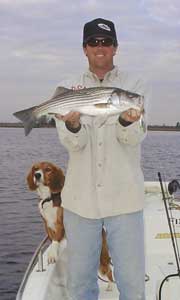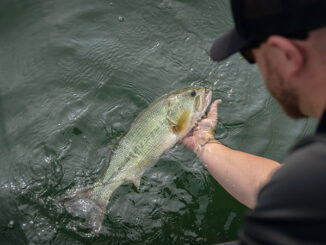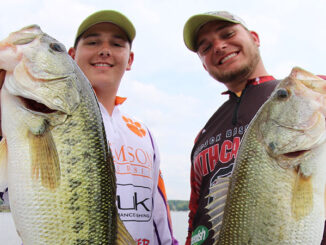
You can forget all your troubles, forget all your cares and go downtown for Wilmington’s waterfront stripers.
Capt. Stuart Caulder’s phone call was direct and to the point.
“Hey, Jerry, the stripers are starting to show up along the waterfront in downtown Wilmington,” he said. “The tide will be right for the next few afternoons.”
Past experiences with Capt. Caulder’s fishing information told me he was making an offer I probably didn’t want to refuse. I quickly replied in the affirmative about his request to fish and asked if he had a day in mind.“Well,” he said. “We can troll or bottom fish with cut bait just about anytime, but the tide will be just about perfect to anchor and cast at one of my favorite spots about 3 p.m. Wednesday. Why don’t you meet me at that ramp right under the Cape Fear Memorial Bridge at 1 p.m., and we’ll go see what we can do.”
In my eagerness, I arrived early. It wasn’t a large area but held adequate parking and a well-maintained double-lane ramp.
The tide had turned and was slowly picking up momentum as it began to fall. The tell-tale current swirls were beginning to trail out on the down-river side of the footings of the bridge that towered overhead.
A few minutes later, Caulder arrived, also a little early.
“I figured you’d be here a little early, so I grabbed a quick lunch and headed on down,” he said. “Let’s get this boat in the water and go see if the fish are going to cooperate.”
In short order, Caulder launched the boat, and we motored south. It was a nice winter afternoon with lots of sunshine and only a jacket required for warmth.
A ship was offloading cargo as we slid past the N.C. State Ports Authority. The port patrol boat was in the water but didn’t approach us as we slowed and eased past the docks. After heading down river a little farther, Caulder throttled back and pointed to a dock at our left.
“I’m going to ease in by this dock and turn back up river,” he said. “Once we get a little up river from the dock, I’ll ask you to hold the boat in place while I get the anchor out. We’ll get the anchor set, then let out some line to get positioned where we can cast back to the pilings.”
Caulder deftly maneuvered the boat into position and slowed the engine until we were holding place against the strengthening current. Handing the controls to me, he stepped forward, eased the anchor out of the anchor locker and over the side. Once the anchor found the bottom, he had me lightly ease back on the throttle until we were slowly drifting backwards. When he felt the anchor take hold, he told me to take the motor out of gear and let him get the boat positioned.
After letting out just a little more line, he secured it to the bow cleat and announced it was time to go fishing.
“Why don’t you start with this green and white grub?” Caulder said. “It’s pretty easy to work, all you have to do is keep it just off the bottom.
“I’ll start with a chartreuse Rat-L-Trap, and we’ll see if they have a preference for one or the other.”
Pointing at the bank, Caulder asked if I could see where the bulkhead turned out on the other side of the dock. Then he told me to begin by casting about two pilings out from there.
“These fish are moving up the river or trying to hold in place against this falling tide,” Caulder said. “They look for anything to break the flow of the current and give them a place to hide and rest a little.
“There are some old pilings and timbers blocking the water between the bulkhead and those pilings, and the stripers have to swim around them to move upstream. They also make a great place for them to hide in water that isn’t flowing quite so fast.
“As the tide falls, you’ll see what I mean as they become visible where that hard swirl and current trail are right now.”
Caulder coached me to cast my bait as close to the piling as I could. He added that a cast under the dock wouldn’t be bad, as long as I didn’t throw it over the bracing or let it sink and become tangled in the jungle of old dock pieces along the bottom.
After only a few casts, something smacked my bait hard and immediately ran around the piling into the tangle of debris. My rod was pulsing hard as the struggles of the fish shot up the Power Pro line.
“Hold on to him and try not to let him get any more line,” Caulder said. “The odds are low of getting him out of there anyway, but the less line he has to get tangled up in there the better your chances are.”
I held the pulsing rod as the fish continued to surge and use the flowing current to help it break free. Just as I thought it might be tiring and give me a chance to lead it out, it made one huge rush and the line parted with a pop.
“I was hoping you might outlast him and get him out, but that only happens about one time in 10,” Caulder said.
Looking at the frayed end of my line, he said it’d gotten chafed by barnacles on the piling and wore until it thinned to the point the striper’s final lunge was enough to break it.
“The good news is now we know there are some fish here today,” Caulder said with a growing smile. “Let me clip this frayed line off and tie on another leader and lure so you can get back to fishing.”
Caulder fishes with a combination of Quantum spinning and bait-casting tackle. He uses the bait-casters well but said most of his customers master spinning gear much quicker. Admitting I was a professional bird-nest builder, I began and ended the day using a 7-foot medium-weight spinning outfit filled with 14-pound-test Power Pro line.
Caulder prefers Power Pro line because it’s one of the modern superbraid lines and has incredible sensitivity. It also has no stretch, which allows anglers to set hooks firmly and quickly control fish. Its smaller diameter also allows the line to cut through the current with less resistance, aiding in finessing lighter lures into preferred locations.
After adding a 2-foot fluorocarbon leader and a new grub head and grub, I was back in business. Meanwhile Caulder was working the Rat-L-Trap deeper and deeper under the pier.
Suddenly, Caulder reared back and the water between two pilings erupted. It wasn’t a particularly large striper, but it wanted back under the dock almost as much as Caulder wanted it out — and it wasn’t anywhere near ready to surrender.
“Man, I hate to have to horse a fish like this, but if I don’t get him out, he’ll break me off just like what happened to you,” Caulder said. “I sure hope these little hooks hold.”
The line and hooks held and Caulder got the struggling striper to our side of the pilings. After a minute or so, he led it up to the boat, lipped it and held it aloft.
“If we were keeping them, it’s a keeper,” he said. “It isn’t much over 3 pounds, but it’s a downtown Wilmington striper.
“These fish move through here during the winter months and give us something to fish for. This one is actually just a little below-average size; we occasionally get some up around 20 to 25 pounds. As you can imagine, those fish are a lot harder to keep out of the pilings.”
After landing a few fish, Caulder began talking about some of the other ways to catch stripers at the Wilmington waterfront.
“As you know, I prefer to anchor or drift and cast to the fish,” he said. “However, with the swift-moving current in this river, you can’t always do that, so we sometimes troll and some folks bottom fish using live and natural baits.
“The primary fishing area is from where the power lines cross the (Cape Fear) river down below the state port docks, up to Point Peter, where the (Cape Fear and Northeast Cape Fear) rivers split across from the Wilmington Hilton.
“I usually concentrate on bulkheads, docks and the sites of old docks with broken off pilings, where the fish can get out of the current a little and wait on something to swim or drift by.
“When I’m trolling, I generally use big-lipped swimming plugs and fish them pretty slow. Some of my favorites are the Rapalas with red heads and white bodies. Greens and chartreuse are usually good colors too. There are days the one-piece bodies attract fish better, and other days when jointed or two-piece plugs do better.”
When trolling, Caulder said he uses a slightly heavier version of the same outfits. The reels are spooled with Power Pro line, which, with its thinner diameter, allows the plugs to dive a little deeper without increasing the trolling speed. After hooking a fish, the lack of line stretch helps get the fish clear of structure.
For trolling, Caulder targets the ends of docks, drop-offs in the river, known structure and the bulkheads along the State Port wharves. He said having a ship in port will move anglers away from the bulkhead, but sometimes the stripers will hang just under the ship, so he trolls as close to them as port security allows.
Caulder said he doesn’t use baitfish, but the ledge, by the junction marker at Point Peter, is a favorite place for bait anglers. Live shad and big chunks of fresh cut shad are preferred baits.
When those sunny winter days come around this winter and anglers need to get in a quick fishing fix, give the Wilmington stripers a try.
They aren’t part of the downtown revitalization project, but they surely can put a spring in the steps of anglers suffering winter doldrums.




